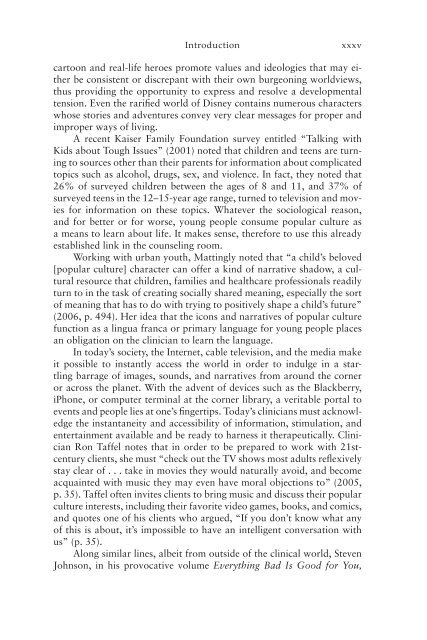Popular Culture in Counseling, Psychotherapy, and Play-Based ...
Popular Culture in Counseling, Psychotherapy, and Play-Based ...
Popular Culture in Counseling, Psychotherapy, and Play-Based ...
You also want an ePaper? Increase the reach of your titles
YUMPU automatically turns print PDFs into web optimized ePapers that Google loves.
Introduction xxxv<br />
cartoon <strong>and</strong> real-life heroes promote values <strong>and</strong> ideologies that may either<br />
be consistent or discrepant with their own burgeon<strong>in</strong>g worldviews,<br />
thus provid<strong>in</strong>g the opportunity to express <strong>and</strong> resolve a developmental<br />
tension. Even the rarifi ed world of Disney conta<strong>in</strong>s numerous characters<br />
whose stories <strong>and</strong> adventures convey very clear messages for proper <strong>and</strong><br />
improper ways of liv<strong>in</strong>g.<br />
A recent Kaiser Family Foundation survey entitled “Talk<strong>in</strong>g with<br />
Kids about Tough Issues” (2001) noted that children <strong>and</strong> teens are turn<strong>in</strong>g<br />
to sources other than their parents for <strong>in</strong>formation about complicated<br />
topics such as alcohol, drugs, sex, <strong>and</strong> violence. In fact, they noted that<br />
26% of surveyed children between the ages of 8 <strong>and</strong> 11, <strong>and</strong> 37% of<br />
surveyed teens <strong>in</strong> the 12–15-year age range, turned to television <strong>and</strong> movies<br />
for <strong>in</strong>formation on these topics. Whatever the sociological reason,<br />
<strong>and</strong> for better or for worse, young people consume popular culture as<br />
a means to learn about life. It makes sense, therefore to use this already<br />
established l<strong>in</strong>k <strong>in</strong> the counsel<strong>in</strong>g room.<br />
Work<strong>in</strong>g with urban youth, Matt<strong>in</strong>gly noted that “a child’s beloved<br />
[popular culture] character can offer a k<strong>in</strong>d of narrative shadow, a cultural<br />
resource that children, families <strong>and</strong> healthcare professionals readily<br />
turn to <strong>in</strong> the task of creat<strong>in</strong>g socially shared mean<strong>in</strong>g, especially the sort<br />
of mean<strong>in</strong>g that has to do with try<strong>in</strong>g to positively shape a child’s future”<br />
(2006, p. 494). Her idea that the icons <strong>and</strong> narratives of popular culture<br />
function as a l<strong>in</strong>gua franca or primary language for young people places<br />
an obligation on the cl<strong>in</strong>ician to learn the language.<br />
In today’s society, the Internet, cable television, <strong>and</strong> the media make<br />
it possible to <strong>in</strong>stantly access the world <strong>in</strong> order to <strong>in</strong>dulge <strong>in</strong> a startl<strong>in</strong>g<br />
barrage of images, sounds, <strong>and</strong> narratives from around the corner<br />
or across the planet. With the advent of devices such as the Blackberry,<br />
iPhone, or computer term<strong>in</strong>al at the corner library, a veritable portal to<br />
events <strong>and</strong> people lies at one’s fi ngertips. Today’s cl<strong>in</strong>icians must acknowledge<br />
the <strong>in</strong>stantaneity <strong>and</strong> accessibility of <strong>in</strong>formation, stimulation, <strong>and</strong><br />
enterta<strong>in</strong>ment available <strong>and</strong> be ready to harness it therapeutically. Cl<strong>in</strong>ician<br />
Ron Taffel notes that <strong>in</strong> order to be prepared to work with 21stcentury<br />
clients, she must “check out the TV shows most adults refl exively<br />
stay clear of . . . take <strong>in</strong> movies they would naturally avoid, <strong>and</strong> become<br />
acqua<strong>in</strong>ted with music they may even have moral objections to” (2005,<br />
p. 35). Taffel often <strong>in</strong>vites clients to br<strong>in</strong>g music <strong>and</strong> discuss their popular<br />
culture <strong>in</strong>terests, <strong>in</strong>clud<strong>in</strong>g their favorite video games, books, <strong>and</strong> comics,<br />
<strong>and</strong> quotes one of his clients who argued, “If you don’t know what any<br />
of this is about, it’s impossible to have an <strong>in</strong>telligent conversation with<br />
us” (p. 35).<br />
Along similar l<strong>in</strong>es, albeit from outside of the cl<strong>in</strong>ical world, Steven<br />
Johnson, <strong>in</strong> his provocative volume Everyth<strong>in</strong>g Bad Is Good for You,

















